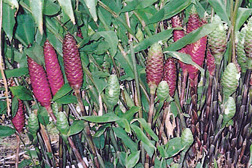
|
In the Garden
|
Leafy shrub can be used for
dye, flavoring and soap
Zingerber zerumbet
Shampoo Ginger
Description: Leafy shrubs (generally the same "ginger plant" shape) reaching heights of about 3 to 5 feet tall. Leaves and flowers emerge from underground stems called rhizomes.
The flowers are white to yellow in color, about 2 inches wide, emerging from a flowering spike which many people mistake for the flower itself. This spike starts off green and eventually turns dark red, and can vary in length from 4 inches to a foot long. Within this spike is a very fragrant, soapy fluid from which the plant gets its common name. This type of 'Awapuhi, like many others, is deciduous, meaning that it loses its leaves two to three months a year.
![]()

Awapuhi loses its leaves annually so is best planted surrounded by other plants to fill in the gaps when it sets back.
Cultural uses: The rhizomes of 'Awapuhi are used to scent and dye kapa while the leaves are used medicinally and also to add flavor to meat. The soapy fluid within the flower spike can be used as a shampoo.
Landscape use and care: Because this plant loses it leaves annually, plant it in an area surrounded by other plants to fill its space when it sets back. Partial to full shade is OK for this plant. Daily watering will help it to look lush and green but is not necessary unless you live in extremely hot areas. Few bugs, if any, are known to bother this plant once it is established in the ground.
Also: Many other species of ginger like the Kahili, yellow, white and shell types are invasive weeds. On Kauai, Maui, Hawaii and Oahu, hundreds of thousands of dollars are spent annually in eradicating these noxious plants from our native forests. Sadly, many of these weeds were intentionally planted to better "scent" our hiking trails without knowledge of the extent of damage they could do.
This plant is available in 3-gallon pots at the Home Depot in Iwilei for about $14.
nativehawaiianplants.com
![]()
E-mail to Features Desk
[News] [Business] [Features] [Sports] [Editorial] [Do It Electric!]
[Classified Ads] [Search] [Subscribe] [Info] [Letter to Editor]
[Feedback]
